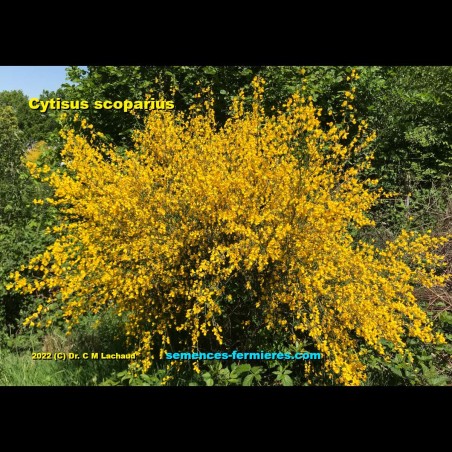








-
Broom grows wild in the wastelands and heaths of semi-mountainous regions with acidic and poor granite soils, hot summers and cold winters (examples: Corrèze, Scotland)
It is grown as an ornamental for its spectacular and abundant yellow flowering in spring, and several cultivars - fragile - exist with white, orange, or red flowers
It was traditionnally used for making brooms, palisades, or natural roofs
Cytisus scoparius is very resistant to cold, wind, drought, and is useful to stabilize or fill slopes and will grow in the most difficult and poor soils
Very fast growing
The wood of Broom is highly sought by artisans
An essential oil is extracted from the flower (perfumery)
The flower is used in the European Pharmacopoeia, and the plant has medicinal properties Anti-arrhythmic, anti-rheumatic, cardiac, Cathartics, diuretics, emetics, and vasoconstrictor
Its medicinal use must be tightly controlled because of alkaloid effects on the heart that make it a dangerous plant to use in self-medication
In spring, the young shoots and the flowers are used as a source of Dye for sulfur yelows and for brown colors with reputation of high light and wash fastness
Vegetation can also be used after blooming and until the beginning of summer for dyeing sad green and brown colors
A brown dye is also obtained from the bark
-
| Jan | Feb | Mar | Apr | May | Jun | Jul | Aug | Sep | Oct | Nov | Dec | ||
|---|---|---|---|---|---|---|---|---|---|---|---|---|---|
| Z5 | |||||||||||||
| etc. | |||||||||||||
Soak the seeds for 24 hours in a glass of water, just before sowing, to help them rehydrate
Sow in seedling soil, in winter or at the very beginning of spring, preferably in a nursery, burying the seeds 1cm deep - germination in spring
Transplant in final location when the plant can be handled, around May-June
Water regularly during the following weeks so that the seedling settles well
Subsequently maintenance-free, requires no fertilization
(nitrogen-fixing plant; in fertile soil, fungal disease problems can appear on the roots and cause the plants to die)
Cytisus scoparius tolerates everything - heat, frost, rain, drought
For acidic and poor soils only
1st flowering 2 years after sowing
-
Learn to Use this Flavonoid Plant with our Courses:
You might also like
Payment :
PayPal < 150 €
Check < 850 €
Bank Wire > 149 €
Thank you for your kind understanding